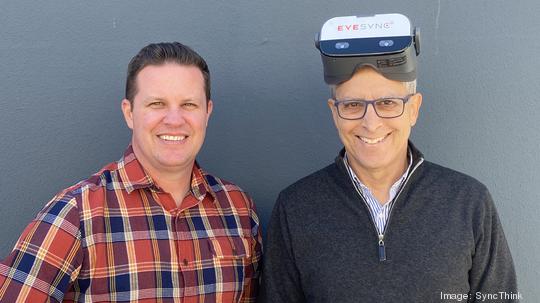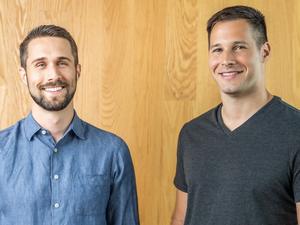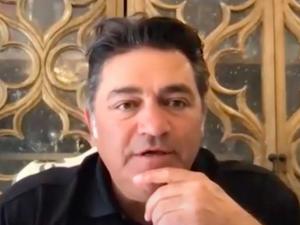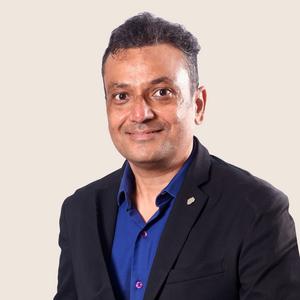
You can tell a lot about people from their eyes.
For SyncThink Inc. that notion is more than just an aphorism; it has the weight of scientific evidence behind it. And the company is using what it's learned about the insights the eyes can offer to help diagnose and treat neurological conditions.
"There are markers in your eye movements that are indicative of disease and pathology," said Scott Anderson, the startup's chief clinical officer. "Neurodegenerative diseases like Parkinson's, schizophrenia, Alzheimer's, dementia ... they all have unique pathologies that can be identified by scanning somebody's eye movements."
Many neurological conditions have traditionally not had well-defined, objective criteria that could be used to diagnose them, Anderson said. So, when determining whether patients were affected with them, physicians have often had to rely on their own judgment, he said.
SyncThink, which is based in Boston area but has what amounts to a second headquarters in Palo Alto, has spent years trying to find objective diagnostic criteria, researching the association of certain irregular movements or focus problems with particular neurological conditions. Using virtual reality headsets to stimulate and track patients' eye movements, the company's software — dubbed Eye-Sync — looks for those known irregularities to help physicians diagnose ailments.
Last month, the Food and Drug Administration gave SyncThink its approval for clinicians to use Eye-Sync as an aid to diagnosing concussions. The U.S. Department of Defense and the Walter Reed National Military Medical Center's National Intrepid Center of Excellence are already using the system to diagnose concussions in soldiers.
"Concussion is a complex condition and a challenge for many clinicians to manage," Dr. Jamshid Ghajar, SyncThink's founder, said in a press release announcing the FDA's move. "We hope that by offering highly accurate diagnostic tools and proven algorithms, we will help providers and their patients identify the most effective and appropriate treatment.”
SyncThink began in 2009 as a research and development company led by Ghajar, who is a neurosurgeon at Stanford University and president of the Brain Trauma Foundation. Ghajar worked with the Department of Defense for more than 10 years to develop the company's software. SyncThink also received $36 million in Defense Department grants as it was developing its system.
The FDA gave its first approval of Eye-Sync in 2016
The startup got its first regulatory stamp of approval in 2016, when the FDA gave it clearance to use its system to track eye movements and analyze the data for abnormalities. The company began commercializing its system the following year. Some 4,000 clinicians — including physicians and rehabilitation specialists — now use its technology.
The company designed its system to complement physicians' assessment's of patients' conditions, rather than substitute for their expertise and experience, said Anderson, who, like Ghajar, is based in Silicon Valley.
"We want to bring objective data in real time to clinicians to allow them to make better diagnoses," he said.
Its move toward regulatory approval and commercialization attracted venture interest interest. Since 2016, it's raised about $7.5 million total through seed and Series A rounds. Among its investors are Quadrant Management and Oceanic Partners. Former San Francisco 49ers quarterback Steve Young is on its advisory board.
- Company: SyncThink Inc.
- Headquarters: Holliston, Mass., Palo Alto
- Chief Clinical Officer: Scott Anderson
- Year founded: 2017
- Employees: 15
- Website: syncthink.com
SyncThink has an ambitious agenda for Eye-Sync and its business. The company has been working to give customers a range of options when it comes to the devices they use to track eye movements. It now has partnerships with Pico Interactive, a Chinese virtual reality headset maker; and Magic Leap, which has developed an augmented reality headset. It also has a deal with Tobii Technology, which has developed its own eye-tracking software that can make use of the cameras built into tablets and notebook computers.
In addition to broadening the devices that can work with its technology, SyncThink has been working to demonstrate the usefulness of Eye-Sync beyond just diagnosing concussions. It's conducting numerous clinical trialstesting the effectiveness of its technology in identifying particular conditions, including attention deficit hyperactivity disorder, Anderson said.
NBA teams including the Washington Wizards and the Atlanta Hawks are exploring Eye-Sync's use as an objective way to determine if their players are fatigued. SyncThink is also working with pharmaceutical companies who are using its system to identify eye movements that have been associated with certain central nervous system diseases, Anderson said.
Eye-Sync could also be used in the future to diagnose schizophrenia and conditions affecting people's sense of balance, he said.
"Your eyes are how you perceive the outside world," Anderson said. "For the longest time, we haven't really understood the human brain, and so this is a huge advancement in understanding how the brain operates."








